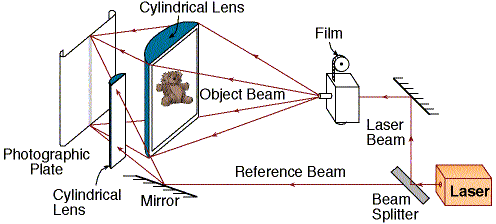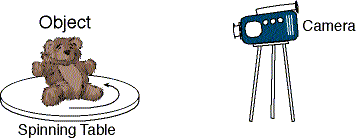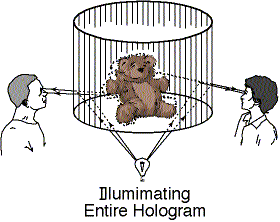Rami Arieli: "The
Laser Adventure" Chapter 10 Section 3, page 20
Video Holography
- Holograms Describing Motion
A variation of the Rainbow hologram is transforming many
2-D images of a body into a 3-D hologram.
Multiplexed Hologram
Multiplexed hologram is a holographic storage of photographic
information.
The result is a 3-D cinematic image that appears to float
in air.
Recording of multiplexed
hologram:
-
First a series of standard film photography of
the body is taken from all 3 dimensions (see figure 10.11a).
At least 3 frames (photos) per 10 of rotation.
Figure 10.11a: Recording the film.
-
The film after development is illuminated
by laser on a semi-transparent screen.

Figure 10.11b: Illuminating the film with a laser.
-
One slit hologram
is made of each frame of the film. The light from the other side of the
screen is projected through a cylindrical lens onto a photographic film,
together with a reference laser beam. A slit (about 1 [mm] width) in front
of the photographic plate limits the exposure to a slit on the film.
Figure 10.11c: Watching the hologram in motion.
-
The images from the slides are holographically
recorded one after the other when the slit is moving along the
photographic film. The result is a holographic film with hundreds of thin
vertical holograms on it.
-
The hologram is bleached (see phase
hologram), so the stripes disappear.
Viewing the hologram
under white light illumination that shines from inside
the cylinder of film, gives a feeling of moving 3-D pictures inside the
cylinder.
Every relative movement of the
eye and the film cause viewing a different hologram. These images
have no vertical parallax, but the
depth feeling is clear.



